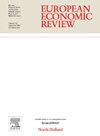目标货币政策、双重利率和银行风险承担
IF 2.8
2区 经济学
Q1 ECONOMICS
引用次数: 0
摘要
我们评估双重利率(中央银行以低于准备金利率的利率提供资金)是否会影响银行信贷的规模和构成。我们利用银行融资成本对欧洲央行宣布于 2020 年 4 月重新调整 TLTROs 的每日反应来衡量该政策的风险敞口。然后,我们使用欧元区信贷登记册来跟踪银行贷款条件和风险承担的演变。我们发现,该措施对银行信贷产生了强烈的积极影响,与标准降息不同的是,风险承担并没有随之增加。本文章由计算机程序翻译,如有差异,请以英文原文为准。
Targeted monetary policy, dual rates, and bank risk-taking
We assess whether dual interest rates – central bank funding at rates below the interest rates on reserves – influence the size and composition of bank credit. We measure exposure to the policy using daily reactions of bank funding costs to the announcement of the recalibration of the ECB’s TLTROs in April 2020. We then use the Euro area credit register to follow the evolution of bank lending conditions and risk-taking. We find that the measure had a strong positive effect on bank credit and, in contrast to a standard rate cut, was not accompanied by an increase in risk-taking.
求助全文
通过发布文献求助,成功后即可免费获取论文全文。
去求助
来源期刊

European Economic Review
ECONOMICS-
CiteScore
4.70
自引率
3.60%
发文量
170
期刊介绍:
The European Economic Review (EER) started publishing in 1969 as the first research journal specifically aiming to contribute to the development and application of economics as a science in Europe. As a broad-based professional and international journal, the EER welcomes submissions of applied and theoretical research papers in all fields of economics. The aim of the EER is to contribute to the development of the science of economics and its applications, as well as to improve communication between academic researchers, teachers and policy makers across the European continent and beyond.
 求助内容:
求助内容: 应助结果提醒方式:
应助结果提醒方式:


